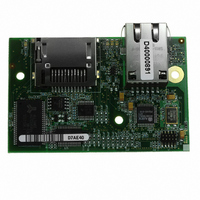20-101-1138 Rabbit Semiconductor, 20-101-1138 Datasheet - Page 38

20-101-1138
Manufacturer Part Number
20-101-1138
Description
RCM4300 RABBITCORE
Manufacturer
Rabbit Semiconductor
Datasheet
1.20-101-1139.pdf
(124 pages)
Specifications of 20-101-1138
Module/board Type
MPU Core Module
Product
Microcontroller Modules
Data Bus Width
8 bit
Core Processor
Rabbit 4000
Clock Speed
58.98 MHz
Interface Type
Ethernet
Flash
2 MBytes
Timers
10 x 8 bit
Operating Supply Voltage
3.3 V
Board Size
72 mm x 47 mm x 21 mm
For Use With/related Products
RCM4300
Lead Free Status / RoHS Status
Lead free / RoHS Compliant
Other names
316-1141
4.2.3 Programming Port
The RCM4300 is programmed via the 10-pin header labeled J1. The programming port
uses the Rabbit 4000’s Serial Port A for communication. Dynamic C uses the programming
port to download and debug programs.
Serial Port A is also used for the following operations.
• Cold-boot the Rabbit 4000 on the RCM4300 after a reset.
• Fast copy designated portions of flash memory from one Rabbit-based board (the
In addition to Serial Port A, the Rabbit 4000 startup-mode (SMODE0, SMODE1),
STATUS, and reset pins are available on the programming port.
The two startup-mode pins determine what happens after a reset—the Rabbit 4000 powers
up in the asynchronous serial bootstrap/triplet mode with the programming cable attached,
and in the clocked serial bootstrap/triplet mode without it. In the Run Mode, where the pro-
gramming cable is not attached, the PIC microcontroller at U6 loads an initial loader that
is stored on its internal flash to the RCM4300 SRAM. The PIC microcontroller communi-
cates with the Rabbit 4000 in the clocked serial bootstrap/triplet mode to load this loader,
then tells the Rabbit 4000 to exit the bootstrap mode and run the loader in SRAM, where-
upon the loader loads the BIOS from the serial flash to the RCM4300 SRAM and runs it.
The BIOS then loads the rest of the program from the serial flash and runs it.
The status pin is used by Dynamic C to determine whether a Rabbit microprocessor is
present. The status output has three different programmable functions:
1. It can be driven low on the first op code fetch cycle.
2. It can be driven low during an interrupt acknowledge cycle.
3. It can also serve as a general-purpose output once a program has been downloaded and
The reset pin is an external input that is used to reset the Rabbit 4000.
Alternate Uses of the Programming Port
All three Serial Port A signals are available as
• a synchronous serial port
• an asynchronous serial port, with the clock line usable as a general CMOS I/O pin
The programming port may also be used as a serial port once the application is running.
The SMODE pins may then be used as inputs and the status pin may be used as an output.
Once the application code is running, the application must then manage sharing Serial Port A
with the programming port (for example, disconnecting the external serial device during
programming and debugging). The SMODE and STATUS pins are similarly not available
during boot-up in order to allow the program to load.
Refer to the
RabbitCore RCM4300 User’s Manual
master) to another (the slave) using the Rabbit Cloning Board.
is running.
Rabbit 4000 Microprocessor User’s Manual
for more information.
38

















